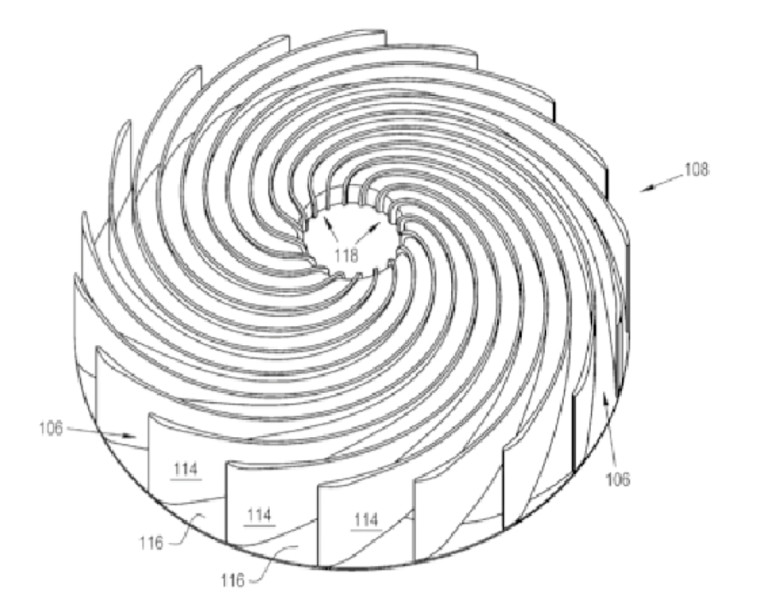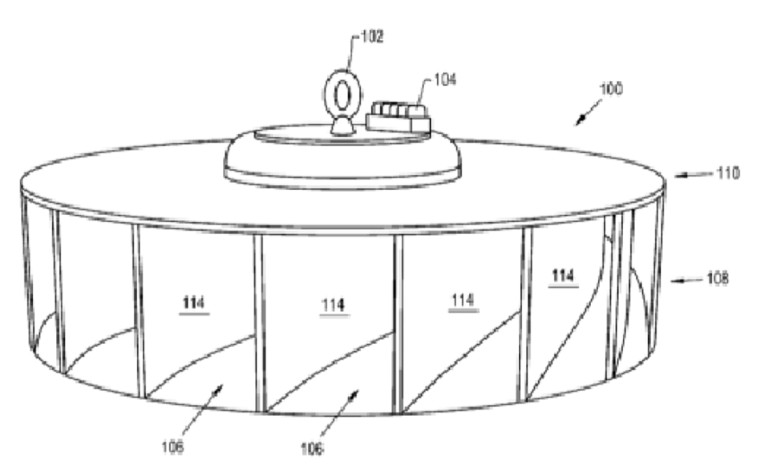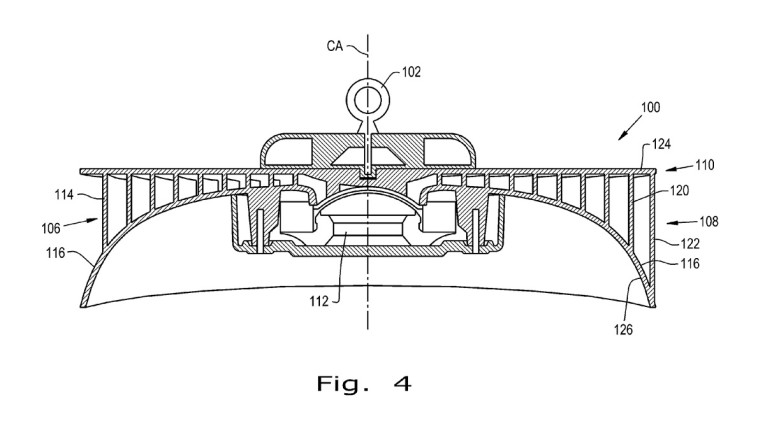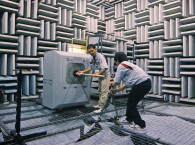
Radial Acoustic Speaker
Patent Number: US 2018/0054672
Inventor(s): Curtis E. Graber (Woodburn, IN)
Assignee: None disclosed
Filed: August 22, 2017
Current CPC Class: H04R 1/30 20130101
Published: February 22, 2018
Granted: September 3, 2019
Number of Claims: 20
Number of Drawings: 7
Abstract from Patent
A radial acoustic speaker assembly including a transducer and a plurality of segmented spiral horns acoustically coupled to the transducer. Each of the segmented spiral horns have an acoustical path. The plurality of segmented spiral horns include a first segmented spiral horn and a second segmented spiral horn. The first segmented spiral horn being adjacent to the second segmented spiral horn, and the first segmented spiral horn and the second segmented spiral horn have substantially identical shapes.
Independent Claims
1. A radial acoustic speaker assembly, comprising: a transducer; and a plurality of segmented spiral horns acoustically coupled to the transducer, each of the segmented spiral horns having an acoustical path, the plurality of segmented spiral horns including a first segmented spiral horn and a second segmented spiral horn, the first segmented spiral horn being adjacent to the second segmented spiral horn, the first segmented spiral horn and the second segmented spiral horn having substantially identical shapes.
15. A speaker assembly, comprising: a first radial acoustic speaker; and a second radial acoustic speaker stacked on the first radial acoustic speaker, both the first radial acoustic speaker and the second radial acoustic speaker each having: a transducer; and a plurality of segmented spiral horns acoustically coupled to the transducer, each of the segmented spiral horns having an acoustical path, the plurality of segmented spiral horns including a first segmented spiral horn and a second segmented spiral horn, the first segmented spiral horn being adjacent to the second segmented spiral horn, the first segmented spiral horn and the second segmented spiral horn having substantially identical shapes.
Reviewer Comments
Horizontally omnidirectional loudspeaker systems are often useful, and sometimes preferable, in certain commercial and consumer applications. While some have been realized from a 360° array of transducers, this approach when applied with a practical number of sound sources, often doesn’t achieve the desired seamless, lobe-free response. The more common approach is to utilize a single transducer mounted in the center and oriented perpendicular to a reflector or a single horn-waveguide with a 360° mouth opening.
Many systems of this type were developed more than 50 years ago using single driver, omni-directional horns, with some of the well developed ones for consumer use, including the work of Daniel Queen in US Patent 4,134,471, “Narrow angle cylindrical wave full range loudspeaker system,” and US Patent 5,359,158, “Ceiling-mounted loudspeaker,” (along with interesting Audio Engineering Society papers on directivity and room interaction) and in the commercial realm of high output emergency notification, US Patent 4,908,601, “Loudspeaker with horizontal radiation pattern,” invented by Bruce W. Howze and assigned to Whelen Technologies.

Prolific audio inventor Curtis Graber has developed his take on the omni-directional horn radiator, with a new multi-spiral waveguide structure driven by a single transducer. Referring to Figure 1, it can be seen that acoustical input is received at the multiple horn throats 118 and proceeds along the length of the individual waveguides to the corresponding mouth exits 106. The curved waveguide sidewalls 114 are capped and contained by bottom plate 116 and top plate 110 shown in the complete structure in Figure 2.

The transducer diaphragm can be of most any form (e.g., a cone or dome structure), but the ideal transducer architecture to match the multiplicity of throats around the periphery of the transducer, is a ring radiator, which naturally provides the least amount of phase loss at higher frequencies. The horn waveguide system operates substantially as a single horn with the same flare rate and a cross-sectional area that is the sum of the invention’s individual waveguides.
A potential advantage of the invention is that for a given total diameter of the device, it can realize a significantly longer effective horn length and commensurate extension in low-frequency bandwidth as compared to the prior art’s single 360° horn of the same diameter. On the other hand, by dividing any waveguide into a multiplicity of smaller cross-sections with the same total cross-sectional area will result in an increase in resistive damping and losses.
It has been found by this reviewer that in all cases of radial, 360° horn devices or ring-emission sources, at the frequency corresponding to a device diameter of 0.786-wavelength, there will be a significant amplitude cancellation.
This is one of the reasons that low-profile, omni-directional horns and reflectors have not been successful. This problematic effect can be substantially eliminated if the height of the structure above and below the center of the opening(s) around the periphery of the waveguide is greater than one wavelength, which can be achieved in devices that are “stacked” as shown in the Figure 3 version of the invention.

Ultimately, this new structure, particularly in the stackable form, should offer solid performance, with the potential for increased low-frequency bandwidth as an advantage over the prior art 360° waveguide devices. VC
This article was originally published in Voice Coil, May 2018.







